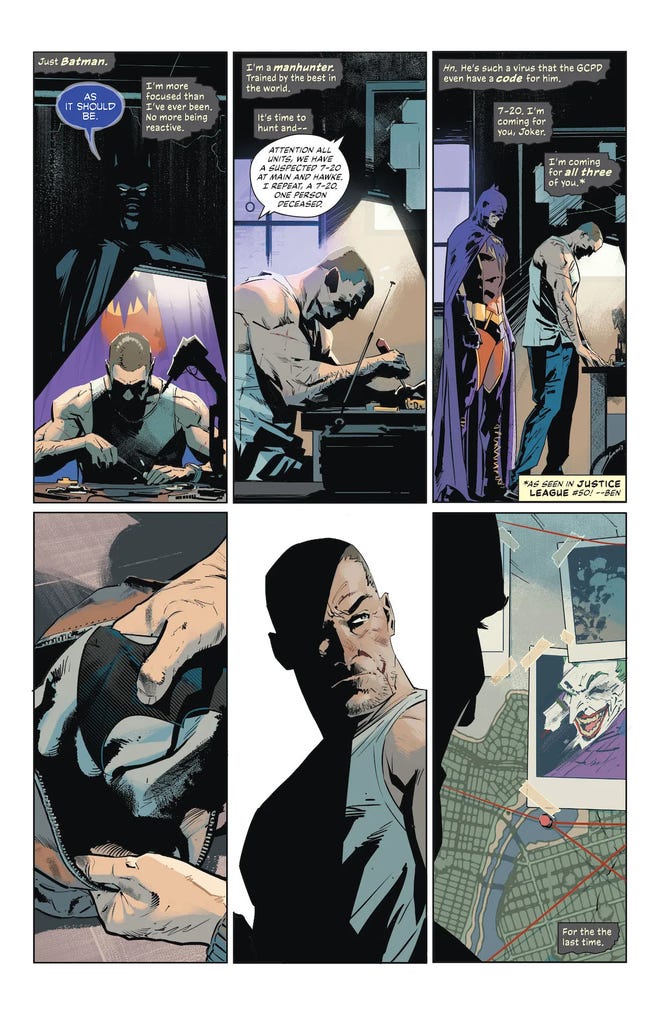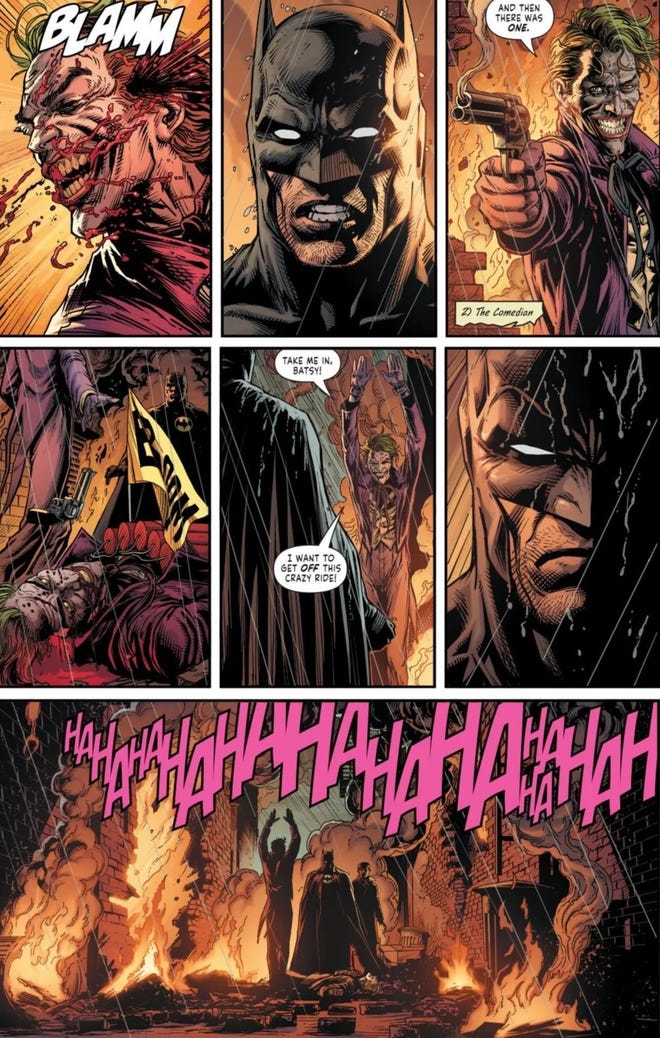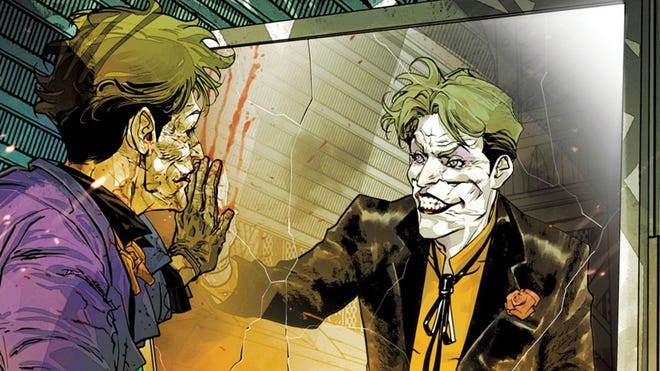Batman and the Joker’s latest showdown invalidates a DC classic
As a new Batman story continues from the ashes of The Gotham War, it makes one popular DC story is no longer canon
In the aftermath of Batman/Catwoman: The Gotham War, the Dark Knight has become obsessed with a mystery that has been plaguing him for the past seven years – the existence of three Jokers active around the DC Universe at once. More than just expanding the threat of Batman’s greatest nemesis, the renewed interest in multiple Jokers appears to definitively place 2020’s DC Black Label miniseries Batman: Three Jokers by Geoff Johns and Jason Fabok outside of mainstream continuity. This mystery kicks off in earnest in Batman #139 by Chip Zdarsky and Jorge Jimenez, with the Joker resurfacing at a time when the Caped Crusader finds himself at his lowest point.
Here’s how the three Jokers returned to the forefront of the DCU after best-selling DC Black Label title seemingly and definitively resolved the story three years ago, how DC has quietly been building to this story for several months and how Batman is in for a tougher fight against the Clown Princes of Crime this time around.
Spoilers for Batman #139 and The Gotham War below!
The Gotham War and return of the three Jokers

In The Gotham War, we learned that Batman was working with the Riddler for information in exchange for the return of henchmen that Catwoman had poached from the Riddler. One subject Batman was keenly interested in learning more about was the three Jokers mystery. If you remember, while sitting on Mobius’ chair in 2016’s Justice League #50 by Geoff Johns and Jason Fabok, Batman used his temporary cosmic awareness to learn that there are three iterations of his arch-enemy active in the DCU.
Even with all the subsequent changes to reality for the DCU, this concept is retained into the DC Rebirth era. Batman's mention of the three Jokers in The Gotham War is the situation is referenced in the Dawn of DC era that began after 2022’s Dark Crisis on Infinite Earths. And this conceptual return comes after Batman is cut off from the rest of the Bat-Family in The Gotham War.
Operating without the support of the Bat-Family and on his own for the first time in years, Batman tracks down the Joker to a decrepit mansion. Inside, Batman learns the Joker is well-aware and excited by the prospect of a one-on-one against his longtime nemesis, playing on knowing the Caped Crusader’s identity as Bruce Wayne by referencing past elements of the Dark Knight’s life. And just as Batman is hoping to face multiple versions of the Joker, the Clown Prince of Crime wants to draw out Bruce’s alternate personality, the Batman of Zur-en-Arrh, triggering the violent alter ego to emerge.
Batman: Three Jokers complicated canonical status

Though the three Jokers may be back, fans will remember that Geoff Johns and Jason Fabok continued and resolved the three Jokers plot point that they introduced in the three-issue 2020 miniseries Batman: Three Jokers. Batman is joined in his investigation by Barbara Gordon and Jason Todd, the two members of the Bat-Family who have suffered the worst from their own separate encounters with the Joker. The story reveals that the original, cold and calculating Joker created two successors, each with their own murderous modus operandi, accounting for the drastic changes in personality across the character’s extensive publishing history.
The three Jokers plan to transform a terminally ill Joe Chill, the man who murdered Batman’s parents, into a Joker to serve as the ultimate iteration of the supervillain. Jason Todd kills one of the Jokers while the modern Joker kills his original counterpart to ensure that the conflict remains focused between him and the Dark Knight. Bruce forgives Chill for killing his parents and is present as he passes away peacefully, with Batman: Three Jokers ending with Batman confirming he is aware of the Joker’s identity as they resume their one-on-one antagonistic dynamic.
Because of DC Black Label titles generally being set outside of continuity, it was unknown if the story should be regarded as canonical to the main DCU. The topic of there being multiple Jokers went unaddressed for years after Three Jokers’ conclusion, while the events of the story itself similarly never were mentioned in subsequent canonical tales. And then the idea of a growing number of Jokers was quietly revived in 2022 with the maxi-series The Joker: The Man Who Stopped Laughing by Matthew Rosenberg and Carmine Di Giandomenico.
The Man Who Stopped Laughing’s multiple Jokers

The Joker: The Man Who Stopped Laughing spun out of James Tynion IV and Guillem March’s Joker ongoing series which had placed the Clown Prince of Crime on the road, fleeing numerous parties seeking revenge on him. The big twist with The Man Who Stopped Laughing is that there is more than one Joker appearing throughout the story. Learning that a Joker is active in Los Angeles, a different version of the supervillain tracks him down, with the two cackling enemies sparring over the course of the story.
As the series progresses, it’s revealed that the Joker creates doppelgangers of himself as a bit of a gag, driving him mad to match his personality through a specialized Joker toxin. By the story’s conclusion, only one Joker is left standing, apparently, with the survivor decapitating his double as he proceeds with his next plan to terrorize Gotham City, back at his old stomping grounds at last. It’s unclear which Joker survived and if the beheading is just another sick joke by the supervillain as the battle lines for a rematch with Batman are quickly drawn.
A more vulnerable Dark Knight

In Batman: Three Jokers, the Dark Knight is backed up by Batgirl and Red Hood to even the odds against the trio of villains, with the Caped Crusader as collected and confident as ever. With this canonical revisit of the three Jokers concept, Batman is completely outnumbered and outmatched, unable to trust even himself. Throughout The Gotham War, Batman brutally fought the Bat-Family as the Batman of Zur-en-Arrh began violently affecting his behavior. Feeling guilty over his behavior, Batman agrees that he shouldn’t have access to the Bat-Family’s resources and insists on staying as a solo, DIY hero for the foreseeable future.
In its own subtle way, Batman #139 appears to confirm that DC Black Label titles are not canonical with the main DCU, specifically through how it discards the narrative legacy of Batman: Three Jokers. Given the intrigue established by The Joker: The Man Who Stopped Laughing, it’ll be interesting to see how the three Jokers concept plays out again, especially given where Batman is at this point in his history. One Joker has put the DCU on the defensive for years and established himself as Gotham’s most nefarious killer. Now with three Jokers and weakened Batman, the villains have more of an advantage than ever.
On sale now, Batman #139 is written by Chip Zdarsky, illustrated by Jorge Jimenez, colored by Tomeu Morey, and lettered by Clayton Cowles. The story continues in Batman #140, on sale December 5 from DC Comics.
Titans: Beast World will set up a new "status quo for the DC Universe" going forward

-(1).jpeg?width=880&quality=80&format=jpg&auto=webp)





